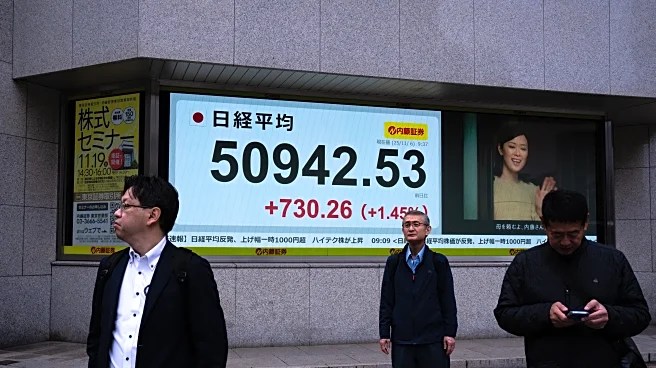What's Happening?
The U.S. dollar experienced a decline against the euro and Swiss franc for the second consecutive session, driven by weak labor market data and the ongoing U.S. government shutdown. According to a report
by Challenger, Gray & Christmas, U.S.-based employers cut over 150,000 jobs in October, marking the largest reduction for the month in more than two decades. This development has heightened expectations for a potential rate cut by the Federal Reserve in December. The dollar's weakness follows a strong rally last week after the Federal Reserve tempered expectations for additional rate cuts this year due to limited economic data, persistent inflation, and internal disagreements among policymakers. The absence of official data during the government's longest-ever shutdown has led investors to rely on private sources for economic insights.
Why It's Important?
The weakening of the U.S. dollar has significant implications for various economic stakeholders. A softer dollar can impact international trade by making U.S. exports more competitive, potentially benefiting American manufacturers and exporters. However, it may also lead to higher import costs, affecting consumers and businesses reliant on foreign goods. The labor market data indicating substantial job cuts raises concerns about economic stability and could influence Federal Reserve policy decisions. The increased probability of a rate cut reflects investor sentiment and could affect borrowing costs, consumer spending, and investment decisions. The ongoing government shutdown further complicates economic forecasting, as the lack of official data creates uncertainty for policymakers and investors.
What's Next?
Traders are now anticipating a 69% probability of a rate cut in December, up from 62% the previous day, according to CME FedWatch. This expectation is significantly lower than the 98% odds priced in late October. The Federal Reserve's next steps will be closely watched, as policymakers navigate the challenges posed by limited economic data and internal disagreements. The government shutdown's resolution is crucial for restoring access to official economic indicators, which are vital for informed decision-making. Market participants will continue to monitor private economic reports and Federal Reserve communications for clues on future monetary policy actions.
Beyond the Headlines
The current economic situation highlights the broader implications of technological advancements and AI-driven changes in the labor market. As industries adopt new technologies, cost-cutting measures may lead to job reductions, raising ethical and societal concerns about workforce displacement. The reliance on private economic data during the government shutdown underscores the importance of transparency and access to reliable information for investors and policymakers. Long-term shifts in monetary policy and labor market dynamics could reshape economic strategies and influence public policy decisions.












